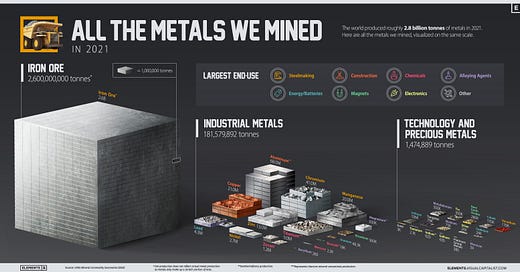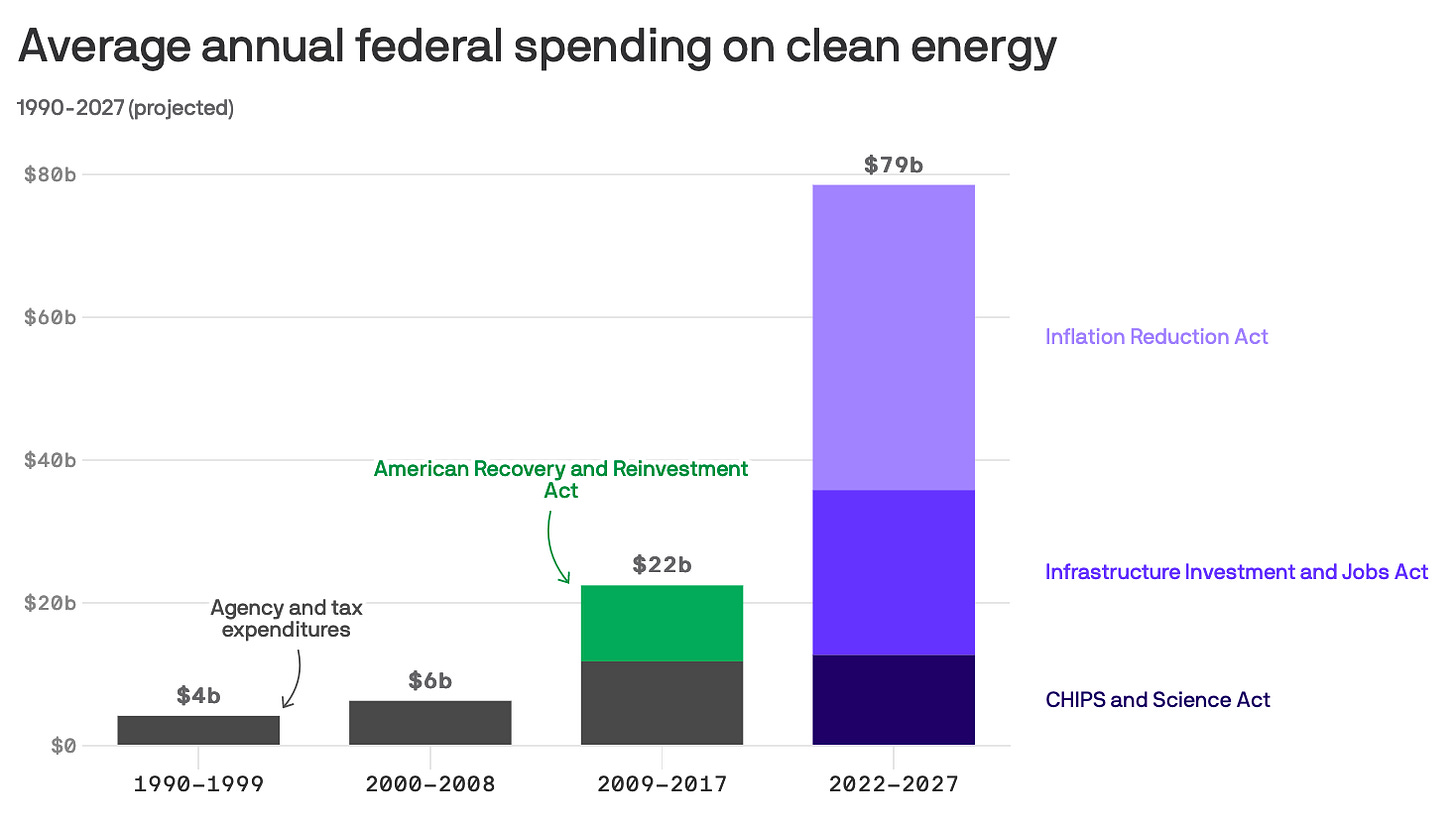Hi everyone, I’m Ben, Founding Partner at Marble. I write a monthly newsletter to share thoughts on the evolving landscape of climate solutions, and ways to increase the rate of progress in society.
In this part two (part one here), I cover the last 6 of 12 climate themes that I’ll be following with attention this year:
🎛️ Carbon removal
🏦 Climate policy
🏗️ Infrastructure
⛏️ Critical metals
🔬 Breakthrough tech
🧠 Metascience
🎛️ Carbon Removal
The IPCC finds in its sixth assessment report that meeting Paris climate goals requires removing 5-16 billion tons of CO2 from the atmosphere every year from 2050 onwards — in addition to deep decarbonisation.
We are not on track. The landmark State of Carbon Dioxide Removal report finds a massive gap between the level of CDR required and what is currently planned. Almost all current CDR comes from land-based approaches.

Novel CDR only accounts for 0.1% and needs to grow by 4 to 6 orders of magnitude in a few decades. In particular, DAC (direct air capture) and other pathways like geochemical CDR and biotech CDR remain in their infancy.
R&D, innovation and deployment are growing rapidly. Public funding reached $4.1bn from 2010 to 2022, with $3.5bn in four DAC Hubs in the US. Patenting has been increasing, especially in China. Between 2020 and 2022 CDR purchases reached $200 million (2022 data here) and VC investment $1 billion.
The launch of Frontier was pivotal. Funded by Stripe, Shopify, Alphabet, Meta and McKinsey, this advance market commitment (AMC) will buy $925 million of durable carbon removal by 2030 in pre-purchases and off-take agreements.
Europe is waking on CDR. While current targets are land-focused, the UK, EU and Switzerland are setting new targets for engineered CDR. Public RD&D is increasing: £90m in the UK, €47m in Germany, €160m in Horizon Europe.
The EU Innovation Fund, a €38 billion demonstrator programme funded by the Emissions Trading Scheme (ETS), put €180m into BeCCS Stockholm. Sweden will purchase €175m of BeCCS per year from 2026 to 2046, and has a long-term net-negative target, like Finland and Germany. France has remained quiet on CDR but the next climate law is an opportunity to raise ambition.
Two things I will follow closely are the proposed CDR certification framework introduced by the EU Commission and the possible integration after 2025 of negative emissions into the EU ETS, which would be massive.
Carbon Gap is a pan-European NGO doing fantastic work across the board. Check out their work if you’d like to make a dent in this space!
🏦 Climate Policy
The federal US government will spend $500 billion on climate infrastructure thanks to the CHIPS and Science Act, the Bipartisan Infrastructure Law, and the Inflation Reduction Act. Broadly speaking the first covers RD&D, the second early deployment and the third creates a demand-pull. These bills cover a broad range of areas across energy, EVs, buildings, carbon removal, critical metals, etc.
In Europe, the IRA sparked anger and frustration due to its massive subsidies. A European IRA seems on the horizon but it’s unclear how much additional money since the €800 billion NextGenerationEU (green recovery) has not been spent. Last year the EU also passed the Carbon Border Adjustment Mechanism which sets an import tariff on carbon-intensive products. Ironically, the CBAM is also being accused of green protectionism.
At the UN level, the IPCC released the final part of its sixth assessment report on mitigation pathways, and COP27 delivered mixed results, with a highlight on the Loss and Damage Fund. This year the UAE will host COP28, whose president heads the national oil company … which is unfortunate.
🏗️ Infrastructure
It’s hard to fathom how much stuff we need to build to solve the climate crisis. Power generation, transmission lines, buildings, bike lanes, electric vehicles, chargers, ships with clean propulsion, heat pumps, hydrogen infrastructure, bioreactors, carbon removal and storage, and all kinds of factories.
Several bottlenecks can constrain how fast we deploy this: capital, workforce development, permitting and social acceptance.
These gaps are more acute for emerging climate solutions where there is no playbook. For instance, there is a capital gap for “early deployments” where neither venture capital nor project finance works. The limited examples of instruments include the DOE Office of Clean Energy Demonstrations, the Loan Program Office, the EU Innovation Fund, the EIF InnovFin Energy Demo, Breakthrough Energy Catalyst, and Generate Capital.

Permitting and social acceptance are also bottlenecks. The IRA might not deliver without permitting reform. Lead times for certain projects can last a decade. Failure to build social acceptance and community support can kill a project: see examples in transmission, wind, nuclear, geothermal, desalination, critical metals. And tomorrow, CO2 storage, bioreactors?
⛏️ Metals and Mining
The energy transition will require a lot of critical elements: mining for metals is often presented as the “dirty secret of clean energy.” Reminder: the amount of material involved is much smaller than what we dig for fossil fuels.
Which elements are critical? Copper is the main electron carrier in the grid. Lithium is the workhorse of EV batteries, which often use nickel and cobalt in the cathode and graphite in the anode. Rare earth elements (REEs) are used to make permanent magnets for electric motors. Platinum group metals (PGMs) are essential for fuel cells and electrolysers.
Multiple challenges make critical metals a wicked problem. Demand will skyrocket: 7x for REEs, 20x for nickel, and 40x for lithium by 2040. Long lead times mean new mining operations take ~16 years to get online. Ore quality is decreasing. Geographical concentration of extraction and processing leads to geopolitical tensions. Finally, social and environmental concerns range from GHG emissions to biodiversity, water stress, safety and human rights issues.
There are many technical levers to pull on this problem, and this is something we’ll work on more with Marble this year!
🔬 Breakthrough Tech
A few scientific highlights in 2022 — far from exhaustive:
Synthetic Biology. Electrochemistry. These two disciplines are arguably the emerging workhorses of the net zero transformation. There are exciting developments every week - apply to Marble if you want to take part!
Q>1 in Fusion. The National Ignition Facility announced a historic 50% net energy again for inertial confinement fusion. This does not include the full facility but this is a historic milestone! Also, 40 fusion startups raised $4.7bn by mid-2022 (disclaimer: I’m a small investor in Renaissance Fusion)
Sodium-Ion. Research on sodium-ion batteries (cheaper, less energy dense) has been going on for a while, but the news is that BYD and CATL might start producing them at scale. And when China builds at scale …
The Merge. The Ethereum blockchain moved to a Proof of Stake algorithm, which reduced energy spending by 99.98% (equivalent to Austria)
Generative AI. Yes, ChatGPT is impressive and I’m excited about what Large Language Models (LLMs) can unlock in applied science. Also, hard to miss the impressive art from DALL-E, Midjourney and Stable Diffusion.
Quantum Nobel. Last year’s Nobel Prize in Physics went to Alain Aspect, John F. Clauser and Anton Zellinger for their work on quantum entanglement, paving the way for quantum computing.
Outer Space. The first discoveries of the James Webb Telescope and NASA’s successful asteroid deflection experiment were exciting.
🧠 Metascience
I’ve been intrigued by progress studies (e.g. how the world improves and how we can get better at it) and the related field of metascience: the science of science.
Institutional innovation for applied science is one specific area of interest, as academia seems broken: from PhD training to tech transfer to how universities and funding agencies operate. The “new science” movement in the US extends beyond ARPA and the corporate labs, to FROs (Focused Research Organisations), fast grants, etc. We need more of this in Europe!
A major development in Europe was the launch of ARIA, the UK’s Advanced Research and Invention Agency, with Ilan Gur as the Founding CEO. I had the chance to spend time with him in London to learn more about how it will work, and I think we need similar agencies across Europe!
I hope you liked this first two-part issue! (part one here)
Hit 💛 and leave a comment + share with a friend
Ben






On two separate occasions in the past 3 years, I learned of electrochemical processes that do extraordinary and unexpected things. My feeling is that use of electrochemical methods in unconventional applications will be rich in new advances.
Super valuable summary :)
On the infrastructure point - interesting (and concerning, although I guess not surprising) that Greg Nemet highlighted on the State of CDR launch webinar last week that their analysis shows that large-scale infrastructure technologies (railroads, pipelines, etc) have typically been the slowest to scale up if you look back at historical examples.
Also some fascinating comments on funding gaps/ the 'valley of death' (specifically within a CDR context) by Andrew Shebbeare on the NTNU Energy Transition Podcast last week.
Matt Clifford (EF Founder) also involved in ARIA I believe - he used to talk a lot about the systems/ institutions/ etc you need to drive scientific progress in his (now largely discontinued) newsletter.
Looking forward to more!